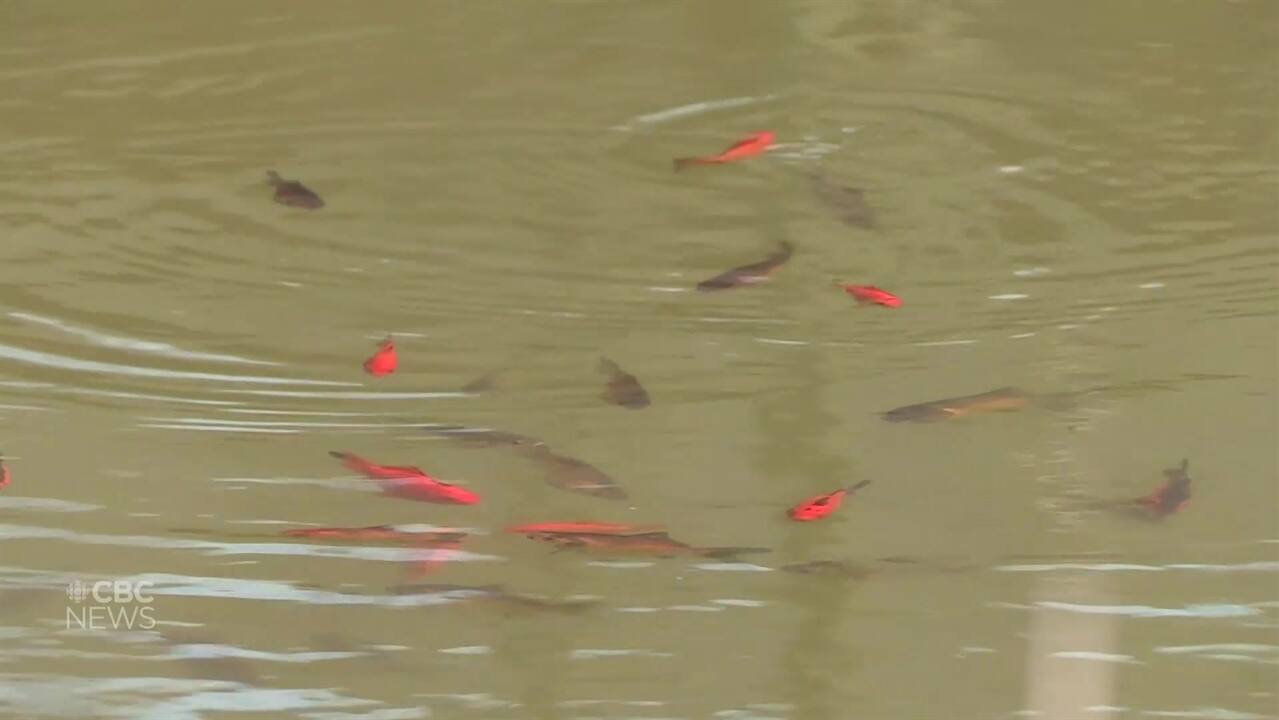Why have goldfish gone from pets to pests in some parts of Canada? | CBC News
For years, Andrew Murray would see the small schools of goldfish living in the storm pond near his home in suburban London, Ont. He never thought much of them until this spring, on a sunny day in April when the normally greenish pond had an unusual, if not slightly orange tinge.
An avid nature photographer, he captured a few close-ups. It wasn’t until he got home and looked at the pictures that he realized how many goldfish must be swimming around in there.
“When I looked at them on my computer later, it was clear there were just thousands and thousands of fish in there.”
Researchers at the University of Toronto believe this scenario is repeating itself hundreds of times in suburban storm ponds all over the province. Originally built to reduce neighbourhood flooding and relieve pressure on Ontario’s city sewer systems, these pools have become ground zero for what Nicholas Mandrak calls “super invaders.”
Ponds ground zero for goldfish invasion
“What we’re seeing is the proliferation of goldfish in suburbs across southern Ontario, in fact across Canada,” said the professor at the University of Toronto Scarborough who studies freshwater fish conservation.
WATCH | Prof. Nicholas Mandrak discusses possible Ontario wild goldfish explosion-climate change link:
Professor Nicholas Mandrak of the University of Toronto Scarborough discusses whether a recent explosion in Ontario’s wild goldfish population is linked to climate change. 1:18
With infestations reported in Alberta, B.C., Saskatchewan, Manitoba and in the United States, goldfish are quickly becoming one of North America’s most prolific invasive species. The reason they’re so widespread is based a lot on how people think of goldfish: harmless and disposable.
“The people who release goldfishes into urban ponds may think they’re doing a good thing, ‘I’m not killing a creature,'” Mandrak said. “There shouldn’t be any fishes in these urban ponds.”
Once introduced into a storm pond, the goldfish start feeding on the insects that would normally colonize it. They spawn rapidly, and their numbers combined with their broad appetites mean they compete with amphibians and other creatures, lowering the diversity of the native species.
They also escape when the ponds flood, releasing the fish into wetlands, creeks, rivers and lakes where Mandrak said goldfish become predators, eating the eggs and fry of other fish.
Rare native species threatened by goldfish
Goldfish also root, almost like an aquatic version of a pig, destroying habitat by uprooting plants and muddying the water for rare and endangered native species such as the spiny softshell turtle, greenside darter and rainbow mussel.
Feral goldfish are out of control in this pond. I wonder what they’re eating. <a href=”https://t.co/yX6xs6JdjR”>pic.twitter.com/yX6xs6JdjR</a>
—@armurray1
Goldish have been in Ontario’s wild waterways since the 19th century, according to Mandrak. What’s changed, however, is the sheer number of them, and he said it likely has to do with the recent addition of suburban storm water ponds and a changing climate, offering the fish more favourable conditions to thrive.
“It’s only recently that they are becoming more abundant,” Mandrak said. “It’s in large part thanks to these urban ponds.
“We also think that climate change is involved as well. The Great Lakes waters and urban ponds warm up greater than they would have previously. The water appears to be more suitable for goldfish.
“As the conditions become more extreme, that is, water that is warm and low on oxygen, one of the few fish that really do well in that type of habitat is goldfish.”
The climate change link
It’s why Mandrak believes goldfish deserve our attention. Not only are we releasing them into the wild, but human-caused climate change is creating the conditions for them to thrive, through warmer water and spread to nearby wetlands, through flooding events caused by more intense rainfall.

It’s why goldfish are found in ever larger numbers in protected Ontario wetlands from Westminster Ponds in London to Cootes Paradise in Burlington.
“There are rapidly increasing numbers of goldfish and I really think that’s climate change,” Mandrak said.
“We see small annual increases of mean annual temperatures leading to much larger and disproportionately larger increases in the number of goldfish because climate change is causing these more extreme environments.”
Part of Mandrak’s research also involves trying to chart the lifecycle of a goldfish infestation in storm ponds, that is, how many generations it takes before the fish take over a body of water.
Scientists can determine the amount of time a goldfish infestation has been in a body of water by the size of its largest fish, which, unconfined by the size of their bowls, have been known to grow to the size of a two-litre pop bottle and weigh up to two kilograms.
“Last year we sampled a pond that was 100 metres by 100 metres, and it contained approximately 20,000 goldfish,” Mandrak said. “We figured they’d been in there for between five and 10 years.”
For all the latest Technology News Click Here
For the latest news and updates, follow us on Google News.


